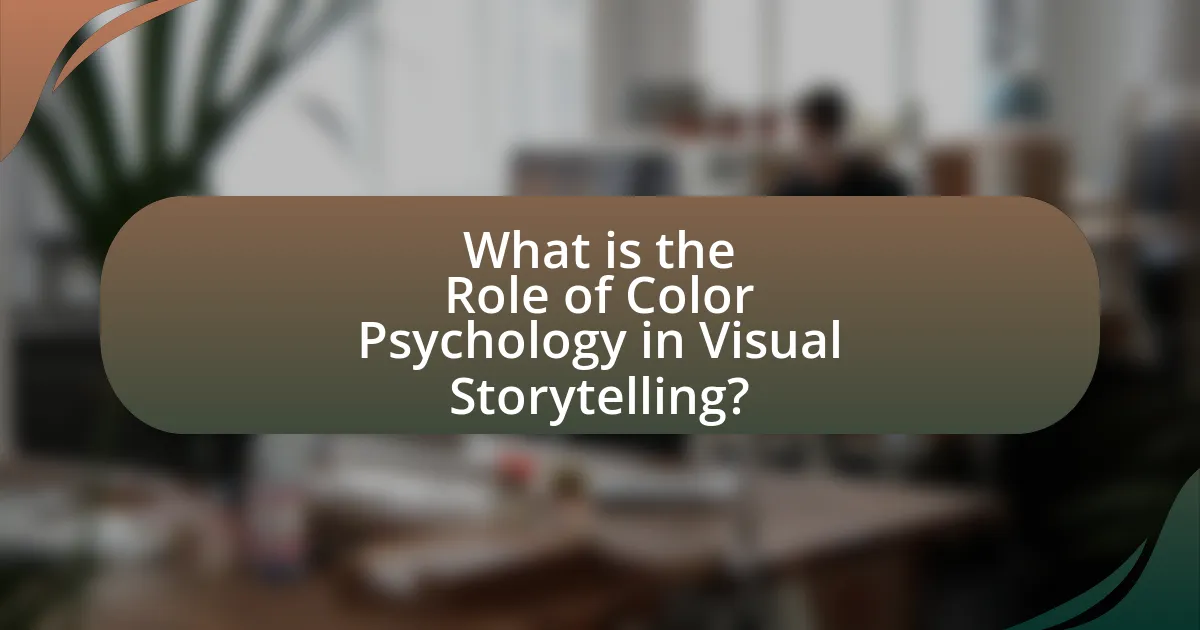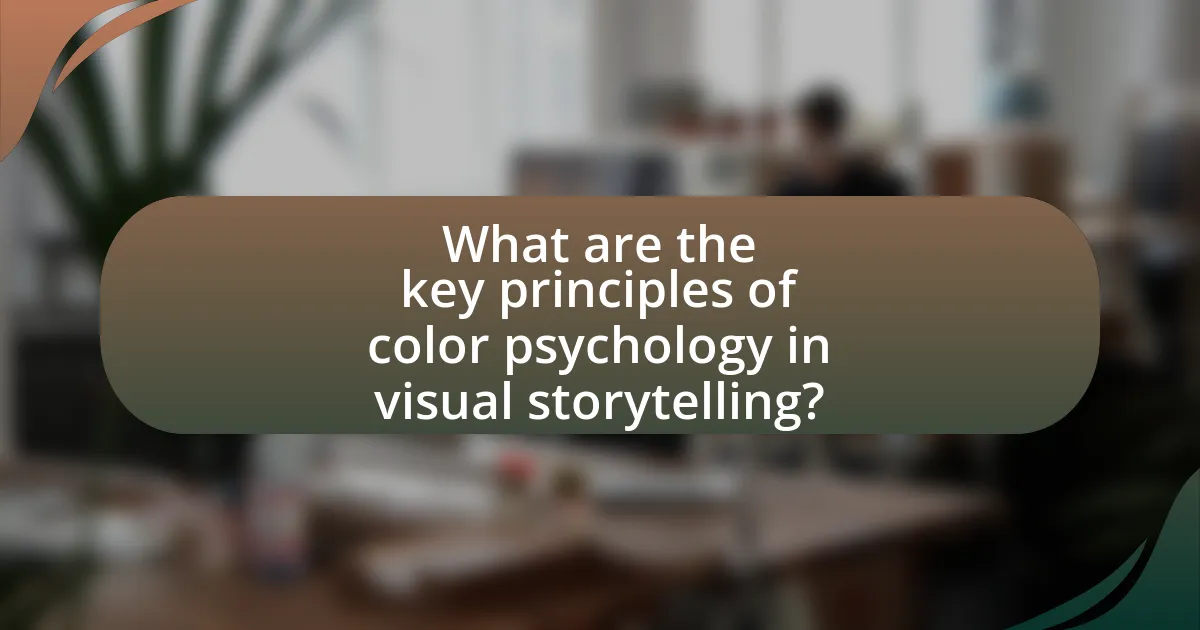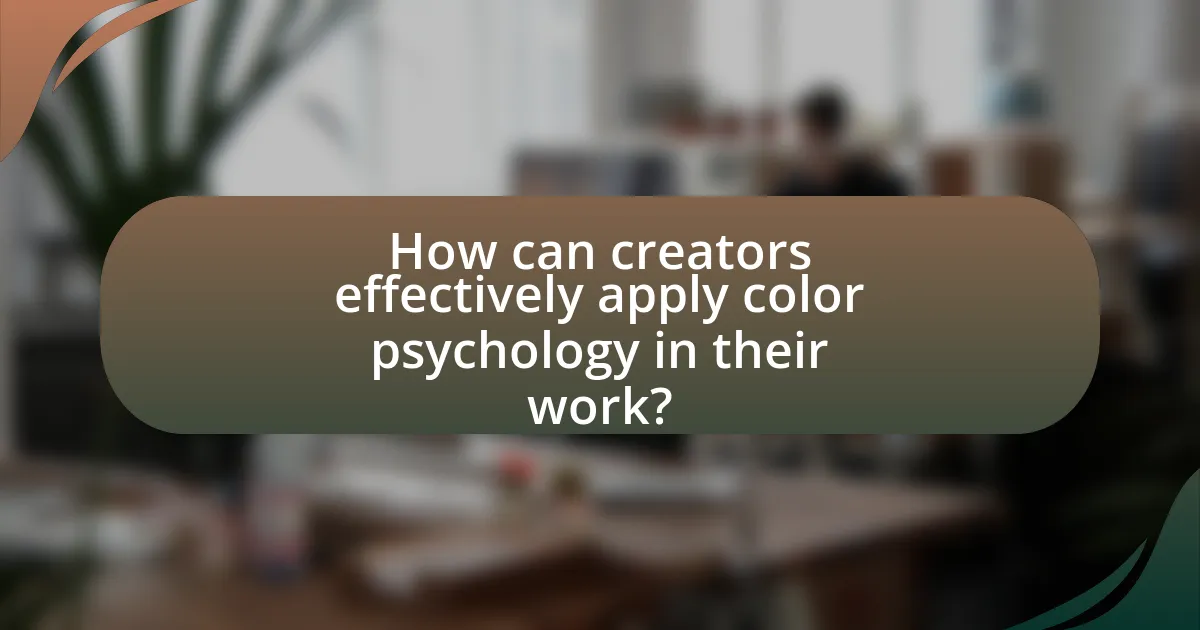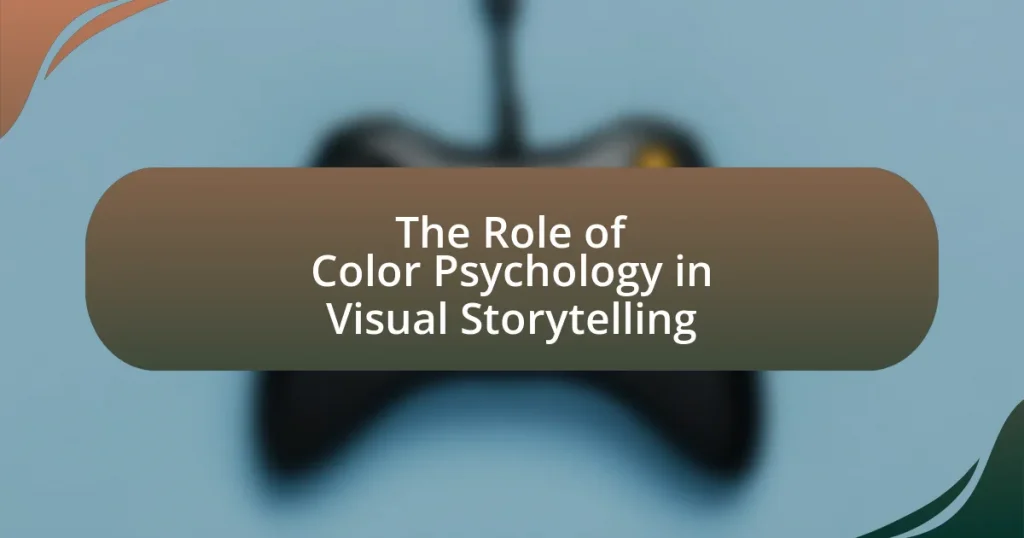The article examines the role of color psychology in visual storytelling, emphasizing how color choices influence emotions, perceptions, and audience engagement. It discusses the psychological effects of different colors, cultural interpretations, and the importance of color selection in enhancing narrative effectiveness. Key principles such as color harmonies, emotional associations, and best practices for integrating color psychology into storytelling are outlined, along with practical tips for creators to ensure consistency and avoid common mistakes. The article highlights the significant impact of color on character development and the overall message of visual narratives.

What is the Role of Color Psychology in Visual Storytelling?
Color psychology plays a crucial role in visual storytelling by influencing emotions and perceptions through color choices. Different colors evoke specific feelings; for example, red can signify passion or danger, while blue often conveys calmness or trust. Research indicates that 85% of consumers make purchasing decisions based on color, highlighting its impact on audience engagement and narrative effectiveness. By strategically using colors, storytellers can enhance the emotional depth of their narratives, guiding viewers’ responses and interpretations.
How does color psychology influence audience perception in visual storytelling?
Color psychology significantly influences audience perception in visual storytelling by evoking specific emotions and associations tied to different colors. For instance, red often conveys passion or urgency, while blue can evoke calmness and trust. Research by the Institute for Color Research indicates that people make a subconscious judgment about a person, environment, or product within 90 seconds of initial viewing, with up to 90% of that assessment based on color alone. This demonstrates that color choices in visual narratives can shape audience reactions and interpretations, guiding their emotional journey and engagement with the story.
What are the psychological effects of different colors on emotions?
Different colors have distinct psychological effects on emotions, influencing human feelings and behaviors. For instance, red often evokes feelings of passion, excitement, or urgency, while blue tends to promote calmness and tranquility. Yellow is associated with happiness and optimism, whereas green is linked to nature and balance, often inducing feelings of relaxation.
Research by Andrew Elliot and Markus Maier in their study “Color and Psychological Functioning: A Review of Theoretical and Empirical Work” published in 2014 highlights that colors can significantly affect mood and cognitive performance. This evidence supports the notion that color choices in visual storytelling can enhance emotional engagement and influence audience perception.
How do cultural differences impact color interpretation in storytelling?
Cultural differences significantly impact color interpretation in storytelling by influencing the meanings and emotions associated with specific colors. For instance, in Western cultures, white often symbolizes purity and innocence, while in many Eastern cultures, it is associated with mourning and death. This divergence in color symbolism can alter the audience’s perception and emotional response to a narrative. Research by Aslam (2006) in the Journal of Fashion Marketing and Management highlights that color meanings are culturally constructed, demonstrating that colors evoke different feelings and associations depending on cultural context. Thus, understanding these cultural nuances is essential for effective storytelling that resonates with diverse audiences.
Why is color selection crucial in visual narratives?
Color selection is crucial in visual narratives because it significantly influences audience perception and emotional response. Colors evoke specific feelings and associations; for instance, red can signify passion or danger, while blue often conveys calmness or sadness. Research indicates that 90% of snap judgments made about products can be based on color alone, highlighting its power in shaping viewer interpretation and engagement. Additionally, color can enhance storytelling by establishing mood, guiding attention, and reinforcing themes, making it an essential tool for effective visual communication.
What role does color play in character development and audience connection?
Color significantly influences character development and audience connection by evoking emotions and symbolizing traits. For instance, warm colors like red can signify passion or aggression, while cool colors like blue often represent calmness or sadness. This emotional resonance helps audiences relate to characters on a deeper level, as colors can reflect their internal states or moral alignments. Research indicates that color can affect viewer perceptions; a study published in the Journal of Experimental Psychology found that colors can alter emotional responses and judgments about characters, enhancing engagement and empathy. Thus, color serves as a powerful tool in visual storytelling, shaping both character identity and audience experience.
How can color enhance or detract from the narrative’s message?
Color can enhance or detract from a narrative’s message by influencing emotional responses and perceptions. For instance, warm colors like red and orange can evoke feelings of passion or urgency, while cool colors like blue and green often convey calmness or tranquility. Research indicates that color choices can significantly affect audience engagement; a study published in the journal “Color Research and Application” by researchers from the University of California found that color can alter viewers’ interpretations of a story’s mood and themes. Therefore, effective use of color aligns with the intended message, while poor color choices can lead to confusion or misinterpretation of the narrative.

What are the key principles of color psychology in visual storytelling?
The key principles of color psychology in visual storytelling include the emotional impact of colors, cultural associations, and the use of color contrast to enhance narrative elements. Colors evoke specific emotions; for instance, red can signify passion or danger, while blue often conveys calmness or sadness. Cultural associations also play a crucial role, as colors can have different meanings across various cultures, influencing audience perception. Additionally, employing color contrast can draw attention to important elements within a story, guiding viewers’ focus and enhancing the overall narrative experience. These principles are supported by studies in psychology that demonstrate how color influences mood and behavior, such as the research conducted by Andrew Elliot and Markus Maier, which highlights the psychological effects of color on emotional responses.
How do color harmonies affect visual storytelling?
Color harmonies significantly influence visual storytelling by establishing emotional connections and guiding audience perception. Different color combinations evoke specific feelings; for instance, complementary colors create tension and excitement, while analogous colors promote harmony and tranquility. Research indicates that color harmonies can enhance narrative elements, as seen in films where color palettes align with character arcs or thematic developments, effectively reinforcing the story’s emotional impact. This relationship between color harmonies and visual storytelling is supported by studies in color psychology, which demonstrate that colors can trigger psychological responses, thereby shaping viewer interpretation and engagement with the narrative.
What are the different types of color harmonies used in storytelling?
The different types of color harmonies used in storytelling include complementary, analogous, triadic, and monochromatic color schemes. Complementary color harmony involves using colors opposite each other on the color wheel, creating high contrast and vibrant visuals, which can evoke strong emotions. Analogous color harmony consists of colors that are next to each other on the color wheel, providing a serene and comfortable aesthetic that can enhance storytelling by creating a cohesive mood. Triadic color harmony utilizes three colors that are evenly spaced around the color wheel, offering a balanced yet dynamic visual experience that can engage viewers. Monochromatic color harmony focuses on variations of a single color, allowing for subtlety and depth in storytelling while maintaining a unified look. These color harmonies are essential in visual storytelling as they influence audience perception and emotional response, supported by studies in color psychology that demonstrate the impact of color on mood and behavior.
How can contrasting colors create tension or highlight themes?
Contrasting colors create tension and highlight themes by establishing visual conflict and drawing attention to specific elements within a composition. For instance, the use of complementary colors, such as blue and orange, can evoke emotional responses and emphasize the dichotomy between opposing forces, such as good versus evil. Research in color psychology indicates that high contrast can stimulate viewer engagement and enhance narrative clarity, as seen in films like “The Grand Budapest Hotel,” where contrasting palettes underscore thematic elements of chaos and order. This strategic use of color not only captures attention but also reinforces the underlying messages of the visual story.
What are the common color associations in storytelling?
Common color associations in storytelling include red for passion and danger, blue for calmness and trust, yellow for happiness and optimism, green for nature and growth, and black for mystery and death. These associations are rooted in color psychology, where red often signifies strong emotions, blue is linked to serenity and reliability, yellow evokes cheerfulness, green represents renewal and life, and black conveys the unknown or fear. Research in color psychology supports these associations, indicating that colors can influence emotions and perceptions, thereby enhancing narrative impact.
How do specific colors relate to emotions and themes in narratives?
Specific colors evoke distinct emotions and themes in narratives, influencing audience perception and engagement. For example, red often symbolizes passion or danger, while blue conveys calmness or sadness. Research indicates that color associations are culturally influenced; for instance, in Western cultures, white represents purity, whereas in some Eastern cultures, it signifies mourning. This cultural context shapes how narratives are interpreted, as seen in films where color palettes are strategically chosen to enhance emotional resonance and thematic depth. Thus, the relationship between colors and emotions in narratives is both psychological and contextual, reinforcing the storytelling experience.
What examples illustrate the effective use of color associations in visual media?
Effective use of color associations in visual media is illustrated by the branding of companies like Coca-Cola and McDonald’s, where red evokes excitement and appetite, respectively. Coca-Cola’s consistent use of red in its branding has been shown to increase brand recognition and consumer engagement, as red is associated with energy and passion. Similarly, McDonald’s employs yellow and red to stimulate hunger and attract attention, which is supported by studies indicating that these colors can enhance appetite and create a sense of urgency. These examples demonstrate how color psychology can significantly influence consumer perception and behavior in visual storytelling.

How can creators effectively apply color psychology in their work?
Creators can effectively apply color psychology in their work by strategically selecting colors that evoke specific emotions and responses from their audience. For instance, research indicates that warm colors like red and orange can stimulate excitement and urgency, while cool colors like blue and green tend to promote calmness and trust. By understanding these associations, creators can enhance their visual storytelling, ensuring that the emotional tone aligns with the narrative. A study published in the Journal of Experimental Psychology found that color can significantly influence perception and behavior, demonstrating that thoughtful color choices can lead to more impactful and engaging content.
What strategies can be used to choose the right color palette for a story?
To choose the right color palette for a story, one effective strategy is to align colors with the emotional tone and themes of the narrative. This alignment can enhance the audience’s emotional connection and understanding of the story. For instance, warm colors like red and orange can evoke feelings of passion or urgency, while cool colors like blue and green can convey calmness or sadness. Research in color psychology supports this, indicating that colors can significantly influence mood and perception; for example, a study published in the journal “Color Research and Application” found that colors can affect emotional responses and decision-making processes. Additionally, considering cultural associations with colors can further refine the palette, as different cultures may interpret colors differently, impacting the story’s reception.
How can mood boards assist in the color selection process?
Mood boards assist in the color selection process by visually compiling colors, textures, and images that evoke specific emotions and themes. This visual representation helps designers and clients align their vision, making it easier to identify which colors resonate with the intended mood or message. Research indicates that color can significantly influence perception and emotional response; for instance, blue often conveys calmness, while red can evoke excitement. By using mood boards, stakeholders can explore these associations and make informed decisions about color palettes that enhance the overall narrative in visual storytelling.
What tools are available for testing color combinations in visual storytelling?
Tools available for testing color combinations in visual storytelling include Adobe Color, Coolors, and Color Hunt. Adobe Color allows users to create and explore color schemes based on color theory principles, providing a platform for visual storytelling applications. Coolors offers a user-friendly interface for generating color palettes quickly, enabling designers to visualize combinations effectively. Color Hunt curates a collection of color palettes that can inspire and guide storytelling through color choices. These tools are widely used in design and marketing, demonstrating their effectiveness in enhancing visual narratives through appropriate color combinations.
What are the best practices for integrating color psychology into visual storytelling?
The best practices for integrating color psychology into visual storytelling include understanding the emotional impact of colors, using color palettes that align with the narrative, and maintaining consistency throughout the visual elements. Research indicates that colors evoke specific emotions; for example, blue often conveys trust and calmness, while red can signify passion or urgency. By selecting a color palette that reflects the story’s themes, creators can enhance audience engagement and emotional resonance. Consistency in color usage across visuals helps reinforce the narrative and aids in audience recall, as demonstrated by studies showing that cohesive color schemes improve brand recognition and storytelling effectiveness.
How can creators ensure consistency in color usage throughout a narrative?
Creators can ensure consistency in color usage throughout a narrative by establishing a defined color palette that aligns with the story’s themes and emotions. This palette should be documented and referenced throughout the creative process to maintain uniformity. For instance, using specific colors to represent particular characters or emotions can reinforce narrative elements and enhance audience engagement. Research indicates that consistent color usage can significantly impact viewer perception and emotional response, as seen in studies on color psychology, which demonstrate that colors evoke specific feelings and associations. By adhering to a predetermined color scheme, creators can effectively guide the audience’s emotional journey and maintain coherence in visual storytelling.
What common mistakes should be avoided when using color in storytelling?
Common mistakes to avoid when using color in storytelling include using too many colors, which can overwhelm the audience and dilute the message. Additionally, failing to consider color symbolism can lead to misinterpretation; for example, red often signifies danger or passion, while blue can evoke calmness. Ignoring the emotional impact of colors can also detract from the narrative; studies show that colors can influence mood and perception, affecting how the story is received. Lastly, neglecting color harmony can result in a visually unappealing composition, making it difficult for viewers to engage with the story.
What practical tips can enhance the use of color psychology in visual storytelling?
To enhance the use of color psychology in visual storytelling, creators should strategically select colors that align with the emotions and themes they wish to convey. For instance, using warm colors like red and orange can evoke feelings of excitement or urgency, while cool colors like blue and green can promote calmness and trust. Research indicates that colors can significantly influence viewer perception and emotional response; for example, a study published in the journal “Color Research and Application” found that color can affect mood and behavior, reinforcing the importance of color choice in storytelling. Additionally, maintaining color harmony through complementary or analogous color schemes can create a visually appealing narrative that resonates with the audience.
